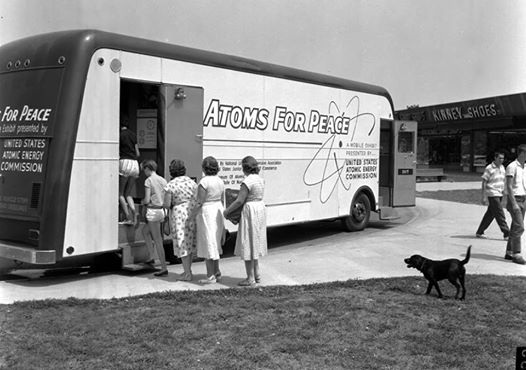
Atoms For Peace public awareness vehicle. Pic via Atomic Samba
‘Atoms for Peace’ was the title of a speech delivered by U.S. President Dwight D. Eisenhower to the UN General Assembly in New York City on December 8, 1953.
I feel impelled to speak today in a language that in a sense is new – one which I, who have spent so much of my life in the military profession, would have preferred never to use.
That new language is the language of atomic warfare.
The United States then launched an “Atoms for Peace” program that supplied equipment and information to schools, hospitals, and research institutions within the U.S. and throughout the world. The first nuclear reactors in Iran and Pakistan were built under the program by American Machine and Foundry.
The speech was part of a carefully orchestrated media campaign, called ‘Operation Candor’, to enlighten the American public on the risks and hopes of a nuclear future. It was a propaganda component of the Cold War strategy of containment. Eisenhower’s speech opened a media campaign that would last for years and that aimed at ’emotion management’, balancing fears of continuing nuclear armament with promises of peaceful use of uranium in future nuclear reactors. The speech was a tipping point for international focus on peaceful uses of atomic energy, even during the early stages of the Cold War. It has been argued that Eisenhower, with some influence from J. Robert Oppenheimer, was attempting to convey a spirit of comfort to a terrified world after the horror of Hiroshima and Nagasaki and of the nuclear tests of the early 1950s.
It presents an ostensible antithesis to brinkmanship, the international intrigue that subsequently kept the world at the edge of war.
via Wikipedia
One thought on “‘Atoms For Peace’ – ‘Emotional Management’ During The Cold War”